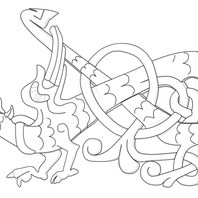
Viking Designs
Drawing of Detail from the Southwell Lintel
The lintel above a door in Southwell Minster features the Archangel Michael fighting off a Norse-style ribbon beast. This drawing shows a detail of the ribbon beast. The lintel is probably an eleventh-century grave cover that was recarved and decorated in the twelfth century and placed into a new position.
Read More
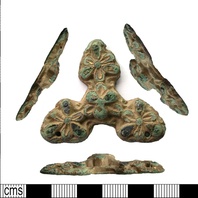
Viking Objects
Carolingian Trefoil Mount (LEIC-C5F14A)
This Carolingian trefoil mount has holes drilled through it for affixing to a surface, possibly a book. It is likely to have been brought from the European continent by Viking raiders or traders.
Read More
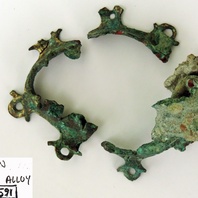
Viking Objects
Gilded Mount (1989-59/7591)
A gilded copper-alloy mount with approximately eight projecting pierced lugs. The mount was found in three pieces and is incomplete. It may originally have been domed, but most of the dome is missing. It has been suggested that it was a shield boss.
Read More
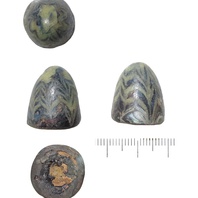
Viking Objects
Glass Gaming Piece (LIN-C31CD7)
There are different possible interpretations of this Lincolnshire find from 2012. It could be a playing-piece as interpreted in the reproductions. Anglo-Saxon playing-pieces of shaped animal tooth are of similar dimensions, while glass counters were used both in the Roman period and taller glass playing men in the Viking period. This find is however considered by some archaeologists more likely to be a decorative setting from fine metalwork. The rather muddy glass colours suggest that the glasses used had already been recycled, and the clay core indicates careful use of a precious resource as well as a means of moulding on a decorated sheet of glass. The best parallels for this find, though none matches the form, are the oval cabochon pieces of dark blue and opaque white glass from the Anglo-Saxon monastery at Monkwearmouth, County Durham. Prominent coloured glass inlays are a part of the Insular tradition with its roots in Ireland. In Irish work the emphasis is on contrasting coloured zones and inlays, technically more complex and in a diverging tradition from this new find, though imitated elsewhere in English work.
Read More
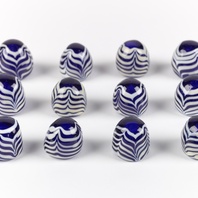
Viking Objects
Reproduction Glass Gaming Pieces
These are reproductions of a conical glass stud found in Lincolnshire, interpreted here as gaming pieces. However analysis of the original on which they are modelled suggests that it could also have been a glass fitting on decorative metalwork.
Read More
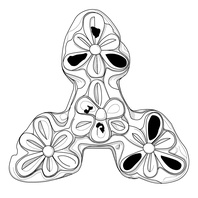
Viking Designs
Drawing of a Carolingian Trefoil Mount
Drawing of a copper alloy and gilded Carolingian mount with niello inlay found in Leicestershire. The mount has holes drilled through it for affixing to a surface, possibly a book, or perhaps to repurpose it as a pendant.
Read More
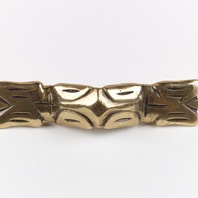
Viking Objects
Reproduction Ansate Brooch
A reproduction, copper alloy, ansate brooch based on an example from York. Two copper alloy examples of ansate brooches, also known as equal-armed brooches, were found at 16-22 Coppergate. These brooches are characterised by a narrow arched bow and terminal heads of identical form. The design of the brooches from Coppergate are a variant known as ‘caterpillar’ type. Asnate brooches are dated to between the seventh and ninth centuries though the finds at Coppergate may extend their popularity into the tenth century. The ‘caterpillar’ variety is typically geographically limited to areas bordering the North Sea. The quantity found in England, however, may indicate local manufacture. Brooches were a typical part of female dress. Scandinavian brooches came in a variety of sizes and shapes which included disc, trefoil, lozenge, equal-armed, and oval shapes. The different brooch types served a variety of functions in Scandinavian female dress with oval brooches typically being used as shoulder clasps for apron-type dresses and the rest being used to secure an outer garment to an inner shift. Anglo-Saxon brooches do not match this diversity of form with large disc brooches being typical of ninth century dress styles with smaller ones becoming more popular in the later ninth and tenth centuries. However, since disc brooches were used by both Anglo-Saxon and Scandinavian women they are distinguished by their morphology. Scandinavian brooches were typically domed with a hollow back while Anglo-Saxon brooches were usually flat. Moreover, Anglo-Saxon brooches were worn singly without accompanying accessories.
Read More
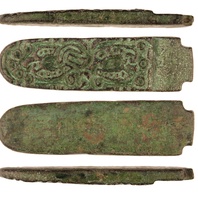
Viking Objects
Jellinge Style Die (LCNCC:1999.27)
This copper alloy metalworker’s die was used for manufacturing decorated pressblech foils. It features an intertwined zoomorphic design in the Jellinge style which was a popular Scandinavian style in the tenth century.
Read More
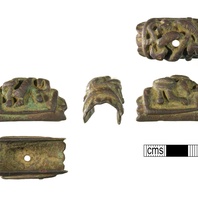
Viking Objects
Decorative Sword Mount (WMID-2FF927)
A cast copper alloy sword mount with English Urnes style decoration which could have been used on the sword pommel. Pommel mounts developed over time from simple rounded or triangular pieces of metal to more stylized multi-pronged designs. They could be decorated with various inlays or gilding. Pommel mounts are often the only indicators for attributing swords to typologies and, therefore, dating them.
Read More
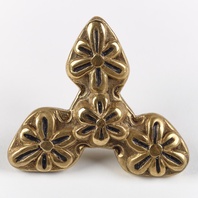
Viking Objects
Reproduction Trefoil Mount
A reproduction of copper alloy and gilded Carolingian mount with niello inlay found in Leicestershire. The mount has holes drilled through it for affixing to a surface, possibly a book, or perhaps to repurpose it as a pendant. These would have most likely been brought over by Vikings who had raided or traded on the European continent.
Read More
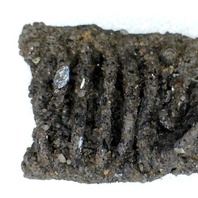
Viking Objects
Silver Wire Embroidery (1988/225-16)
This silver wire was found in Mound 11 at Heath Wood, Ingleby, Derbyshire. This burial mound contained fragments of the remains of an adult human together with the cremated remains of animals, including a small dog, a horse and sheep. The burial was accompanied by this silver wire, an iron spade shoe, some small iron nails and some corroded metalwork. The silver wire was found in two parts with traces of carbonised fibres attached. This suggests that it was probably attached to a piece of cloth. Silver and gold embroidery are known from a number of Viking Age graves, including from nearby Repton, Derbyshire, as well as further afield, e.g. Birka, Sweden. At Birka, wire embroidery was found on caps and headbands, although there is no reason to think that it was only used on headgear at all times.
